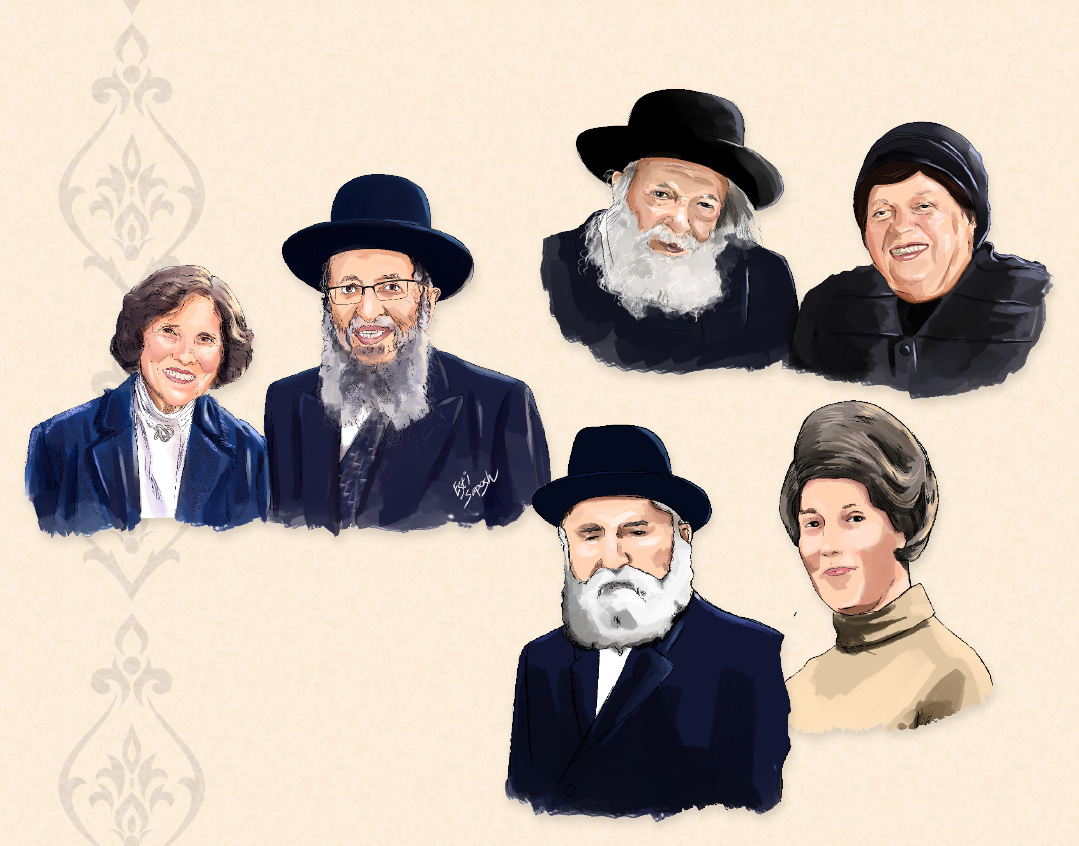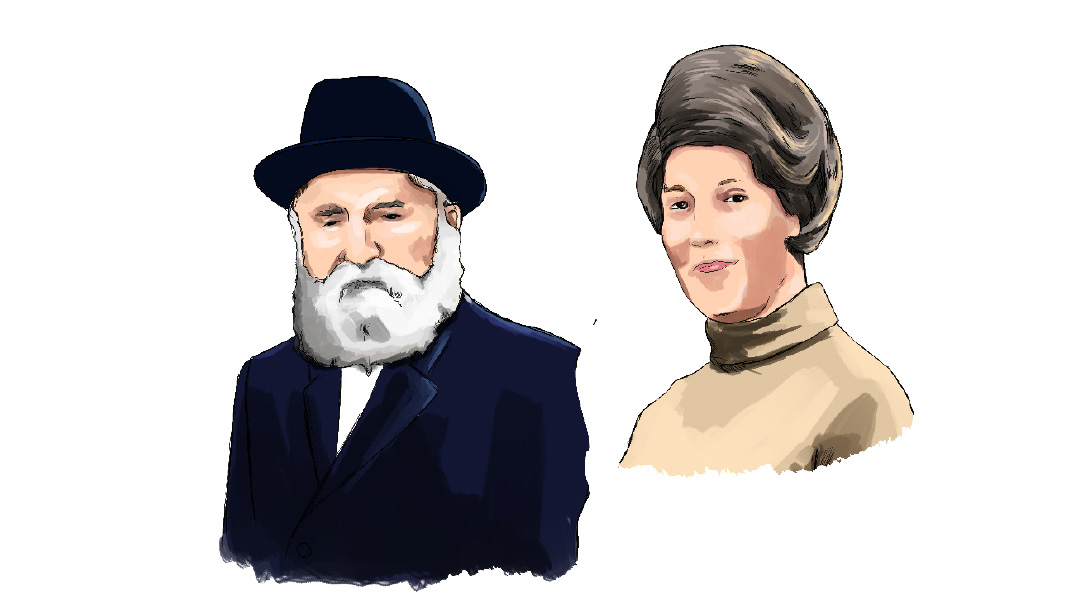Joint Forces

How gedolim built marriages infused with loyalty, purpose, deep respect, and affection

A look at the relationships of some of our greatest couples — unions with different dynamics, different breakdown of roles, different flavors — but with deep respect and affection we can all learn from
The Most Privileged
Rav Moshe and Rebbetzin Sima Feinstein

Rebbetzin Sima, wife of American Jewry’s ultimate posek, Rav Moshe Feinstein, demonstrated utmost respect for her husband. Family members recount that not only was the respect mutual, it was accompanied by deep gratitude and genuine affection
IT
was 1922, time for Sima Kustanovich, the “princess” of her town of Luban, Belarus, to get married. Shadchanim suggested the cream of the crop, the top boys in the area. The name Moshe Feinstein, the young rav of Luban, was the most illustrious one, but she just had one issue with the idea: “He’s a head shorter than me,” she said doubtfully to her father, Rav Yaakov Moshe, who was rosh hakahal of the town.
He reassured her she needn’t meet the short illui. “It’s fine,” he said. “Don’t meet with him. But just know, I will die if you don’t.”
She met him.
And the short man, with his loyal wife at his side, very soon became greater than them all.
During their engagement, the young couple went to seek a brachah from Rav Isser Zalman Meltzer, one of Rav Moshe’s rebbeim and the rav of the nearby town of Slutzk.
“All the townspeople came to their doorsteps to stare at me,” Rebbetzin Sima would later recount. “They all wanted to see the fortunate young woman who would marry their rav’s beloved talmid. I felt like visiting royalty.”
Throughout the ensuing 65 years of their marriage, that feeling never left her.
They married that same year, settled in Luban, and brought four children into the world. Pesach Chaim, the eldest, was niftar at three years old from whooping cough. That left Fia Gittel, Shifra, and Dovid. Later, after immigrating to the United States, they were blessed with their youngest, Shalom Reuven.
If you wanted to characterize the tenor of their relationship in a single phrase, it would be “hakaras hatov.” Reb Moshe and Rebbetzin Sima recognized not only each other’s obvious kochos, but also the specific gifts they gave each other in their marriage. When they married, they agreed on a “division of power”: Rav Moshe wouldn’t help around the house, but would take care of all the ruchniyus. (Rav Moshe would later remind his talmidim that they had made no such conditions, and they must help their wives.) Over the ensuing years, that arrangement was tested many times, but they adhered to the terms: Rebbetzin Sima assumed all responsibility for the logistics of running their home and raising their family, and Rav Moshe focused on ruchniyus — not only of his family’s, but also that of his town, and eventually that of his yeshivah and Klal Yisrael.
During the early years of marriage, the system that existed in Belarus was that instead of paying the rav a salary, the community would grant the rav a store with a monopoly on a particular item, usually candles or yeast or both, and the residents of the town would then go purchase that item from there, thus suppling the rav with an income. Rav Moshe’s store sold yeast. He was meant to sit behind the counter and man the store, as was done in hundreds of kehillahs, but Rebbetzin Sima told him it was beneath his kavod to do so, and that she would sit and mind the store while he went to learn.
If ever she couldn’t mind the store that day, Rav Moshe would sit there and tell customers to take what they need and then come back and pay when she returned. He had such hakaras hatov that she ran the store for him, and said she had an additional portion in the Torah he learned.
After the Communists shut down all businesses, the community put a surcharge on shechitah, and that surcharge was given to the rav as his parnassah.
Eventually, all rabbanim resigned from their positions, as the government demanded they pay an impossibly high tax for the position of rabbiner. But Rav Moshe never resigned; he felt it would be a chillul Hashem as the Communists would see his resignation as a capitulation to their ideals and make comments about “another Jewish rabbi seeing the light.” With Rebbetzin Sima’s unwavering support, he gave what little money they had to pay the rabbiner tax. Eventually, when they couldn’t afford it, their house was confiscated as payment, and the young family had to share a home with the local shoemaker. Throughout it all, the couple was in agreement: It was worth the price not to make a chillul Hashem.
After over a decade of increasing tension from the Communist authorities, it became clear that the Feinsteins had to leave the Soviet Union. In 1931, Rav Moshe reached out to Rav Isser Zalman Meltzer, who had by then moved to Eretz Yisrael. He had a burning desire to head to Artzeinu Hakedoshah. But the British refused his application.
Leaving the Soviet Union required two steps: receiving authorization to leave and being accepted into another country.
The Feinsteins applied for permission to leave, but they were turned down. Apparently, Rav Moshe was already too well known for his brilliance and the Mother Country was reluctant to share home-grown brilliance with anyone else.
In later years, the Leningrad Library featured Rav Moshe’s seforim with an index stating: written by famous Soviet author Moshe Feinstein. They wanted to take all the credit.
Rebbetzin Sima came up with a plan. She advised Rav Moshe to move to Moscow alone for six months, live there in anonymity, and try to obtain visas as a typical Russian, without his Lubanese “rabbiner” title. She would stay in Luban with the children and care for the family on her own, as difficult as that was.
Rebbetzin Sima then reached out to her youngest brother Rav Nechemiah (Kustanovich) Katz, who had left Russia for America years earlier and assumed a rabbinic position in Toledo, Ohio. She asked her brother to help obtain visas for her family. He pulled strings with Senator Robert Taft, son of President William Howard Taft. Taft was friendly with Andrei Gromyko, then the Soviet Union’s foreign minister. Gromyko sent a letter to Moscow asking for permission for the Feinsteins to leave, and visas were issued.
At long last, the visas were in Rav Moshe’s hand. He returned to Luban, and the family packed up to go to Riga, then got the permission to go to America. They remained in Riga for two months.
Before Rav Moshe left the flock he’d led for so many years, he prepared a Hebrew calendar for them meant to last the next 15 years. Unfortunately, within five years, they were all killed by the Nazis in 1942, including Rebbetzin Sima’s father and brothers and their families. Rav Moshe’s brother, Rav Mordechai Feinstein, the rav of Shklov, was sent to his death in Siberia. Two of Rav Moshe’s brothers and his brother-in-law and sister were also killed.
Rav Moshe always reminded his rebbetzin that her binah yeseirah and prescient plan were the reasons, b’chasdei Hashem, they made it out of Europe.
When the boat carrying the Feinsteins docked on American shores, there was a delegation of over 1,000 people, led by Rav Moshe Soloveitchik, waiting to greet them. The Yiddishe newspapers published articles with the headline: “Ari alah mi’Bavel.” The Jewish community was overjoyed at his arrival; they knew they needed him at their helm.
Shortly afterward, three leading rabbanim of the times were involved in a din Torah with a local shochet. In order to give Rav Moshe parnassah, the rabbanim asked him to assist. He heard out the case, examined all the facts… and ruled in favor of the shochet.
The rabbanim were fuming.
The next morning, Rav Moshe woke up to find a line of people forming from their door up the street. They all wanted an honest psak from a rav who wasn’t afraid to say the truth.
Oops! We could not locate your form.







